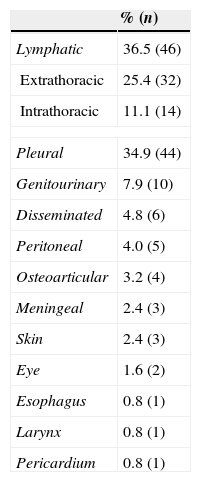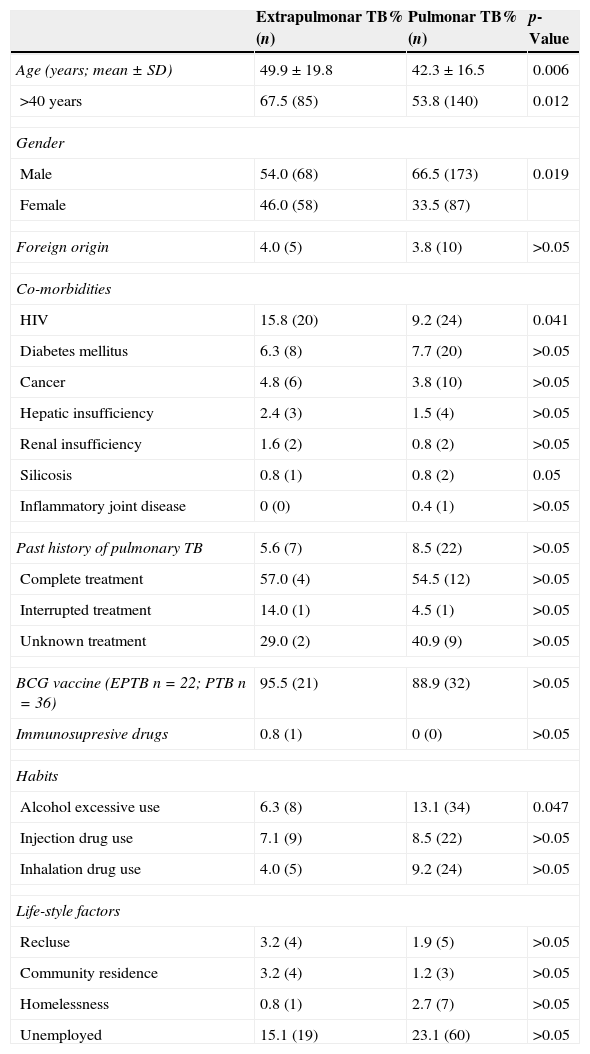Tuberculosis (TB) remains a major global public health problem and 20% of all cases are extrapulmonar. The purpose of this study was to identify risk factors associated with extrapulmonar tuberculosis.
MethodsWe carried out a transversal study which included all patients with extrapulmonary tuberculosis registered in a TB reference center in northern Portugal, between January 2008 and January 2012. We evaluated demographic data, comorbidities, BCG vaccination and previous tuberculosis treatments. Multivariable logistic regression was used to identify independent risk factors (p<0.05).
ResultsAmong the 386 patients studied, 260 (67.4%) had pulmonary tuberculosis (PTB) and 126 (32.6%) extrapulmonary TB (EPTB). Age over 40 years old (OR=2.09; 95%CI: 1.29–3.38), female gender (OR=1.63; 95%CI=1.02–2.6) and HIV infection (OR=2.72, 95%CI=1.25–5.93) were independent risk factors for EPTB. Alcoholism (OR=2.22, 95%CI: 1.00–4.95) was associated with higher risk for PTB. Previous liver disease (OR=22.30; 95%IC: 1.89–263.57) was an independent risk factor for peritoneal TB. HIV co-infection (OR=12.97; 95%IC: 1.71–48.42) and the presence of previous TB treatment (OR=7.62; 95%IC: 1.00–57.9) increase the risk of disseminated disease.
ConclusionWe identified independent risk factors for EPTB. Recognizing risk factors associated with EPTB is essential for suspicion of disease and may help make an accurate diagnosis.
Tuberculosis (TB) remains a major global health problem. In 2012, it was estimated that there were 8.6 million of new TB cases (1.1 million attributed to HIV co-infection) and 1.3 million deaths due to the disease.1 In the last two decades active TB disease has globally decreased by 37% in the community setting,1 however this reduction is mainly in pulmonary tuberculosis (PTB), since the prevalence of extrapulmonary tuberculosis (EPTB) has remained stable.2 In 2012, 0.8 million (16%) EPTB cases were notified worlwide.1 In Portugal this percentage is higher, with 27% of EPTB cases notified.1
Contrary to what happens in PT (where there have been numerous, large studies), research in EPTB is considerably smaller and has received less attention from public health entities. This is probably due to the fact that most forms of EPTB do not contribute to the transmission of tuberculosis. However, EPTB significantly contributes to TB-related morbidity and may be a direct cause of complications, sequelae and lifelong disabilities.
There are many factors that may contribute to a delay in the diagnosis of EPTB. EPTB has highly heterogeneous manifestation. Therefore, patients are often observed by different specialists, with little experience in the diagnosis of tuberculosis. Obtaining diagnostic samples can be another obstacle, since it is often necessary to use invasive methods to obtain samples and laboratory diagnostic tests for the EPTB have lower yield in extrapulmonary samples. The concepts inherent to EPTB treatment are similar to those of PTB, however there are specific situations that require specific interventions such as corticosteroids as adjunctive therapy or extending the duration of treatment.
It is clear that clinicians should be aware of the risks factors associated with this disease as this is the first step toward diagnosing EPTB. The correctly and timely fashion in which the various forms of EPTB are diagnosed is crucial as it can minimize the morbidity and mortality of these patients.
MethodsIn order to identify the most common determinants associated with extrapulmonary involvement in tuberculosis patients, a retrospective study was carried out between January/2008 and January/2012. The study included all tuberculosis patients (386) followed at the Pulmonology Diagnostic Center of Vila Nova de Gaia, Portugal.
PTB diagnosis criteria were the existence of respiratory symptoms and isolation of Mycobacterium tuberculosis in samples of sputum and/or bronchoalveolar lavage. The criteria for EPTB diagnosis were the existence of suggestive clinical and radiological change as well as isolation in culture and/or nucleic acid amplification tests for Mycobacterium tuberculosis in extrapulmonary samples and/or existence of suggestive histological alterations (granuloma and/or caseation). Patients with both PTB and EPTB were included in the group of EPTB.
We analyzed demographics, co-morbidities, immunossuppressive therapies and existence of previous TB treatment. Univariate and multivariate logistic regression were performed. Odd-ratios and the associated 95% confidence intervals were reported. Statistical significance was reported for p-values <0.05.
ResultsDuring the period studied, 386 patients were included: 260 PTB cases (67.4%) and 126 EPTB cases (32.6%). The most common forms of EPTB were lymphatic (36.5%), pleural (34.9%) and genitourinary (7.9%) (Table 1). Of the 126 cases of EPTB, 11 (2.8%) had concurrent PTB.
Distribution of extrapulmonary tuberculosis case by site of disease.
| % (n) | |
|---|---|
| Lymphatic | 36.5 (46) |
| Extrathoracic | 25.4 (32) |
| Intrathoracic | 11.1 (14) |
| Pleural | 34.9 (44) |
| Genitourinary | 7.9 (10) |
| Disseminated | 4.8 (6) |
| Peritoneal | 4.0 (5) |
| Osteoarticular | 3.2 (4) |
| Meningeal | 2.4 (3) |
| Skin | 2.4 (3) |
| Eye | 1.6 (2) |
| Esophagus | 0.8 (1) |
| Larynx | 0.8 (1) |
| Pericardium | 0.8 (1) |
The median age of EPTB patients was higher than PTB patients, with a male: female ratio of 1.2 in EPTB vs 2.0 in PTB (p<0.05) (Table 2). The comorbidities most frequently observed in both groups were HIV-coinfection and diabetes mellitus, HIV positive being more prevalent in the EPTB (p=0.041).
Comparison of extrapulmonary and pulmonary tuberculosis according to demographic, life style and clinical characteristics.
| Extrapulmonar TB% (n) | Pulmonar TB% (n) | p-Value | |
|---|---|---|---|
| Age (years; mean±SD) | 49.9±19.8 | 42.3±16.5 | 0.006 |
| >40 years | 67.5 (85) | 53.8 (140) | 0.012 |
| Gender | |||
| Male | 54.0 (68) | 66.5 (173) | 0.019 |
| Female | 46.0 (58) | 33.5 (87) | |
| Foreign origin | 4.0 (5) | 3.8 (10) | >0.05 |
| Co-morbidities | |||
| HIV | 15.8 (20) | 9.2 (24) | 0.041 |
| Diabetes mellitus | 6.3 (8) | 7.7 (20) | >0.05 |
| Cancer | 4.8 (6) | 3.8 (10) | >0.05 |
| Hepatic insufficiency | 2.4 (3) | 1.5 (4) | >0.05 |
| Renal insufficiency | 1.6 (2) | 0.8 (2) | >0.05 |
| Silicosis | 0.8 (1) | 0.8 (2) | 0.05 |
| Inflammatory joint disease | 0 (0) | 0.4 (1) | >0.05 |
| Past history of pulmonary TB | 5.6 (7) | 8.5 (22) | >0.05 |
| Complete treatment | 57.0 (4) | 54.5 (12) | >0.05 |
| Interrupted treatment | 14.0 (1) | 4.5 (1) | >0.05 |
| Unknown treatment | 29.0 (2) | 40.9 (9) | >0.05 |
| BCG vaccine (EPTB n=22; PTB n=36) | 95.5 (21) | 88.9 (32) | >0.05 |
| Immunosupresive drugs | 0.8 (1) | 0 (0) | >0.05 |
| Habits | |||
| Alcohol excessive use | 6.3 (8) | 13.1 (34) | 0.047 |
| Injection drug use | 7.1 (9) | 8.5 (22) | >0.05 |
| Inhalation drug use | 4.0 (5) | 9.2 (24) | >0.05 |
| Life-style factors | |||
| Recluse | 3.2 (4) | 1.9 (5) | >0.05 |
| Community residence | 3.2 (4) | 1.2 (3) | >0.05 |
| Homelessness | 0.8 (1) | 2.7 (7) | >0.05 |
| Unemployed | 15.1 (19) | 23.1 (60) | >0.05 |
Previous history of TB was more common in PTB (p>0.05). The excessive use of alcohol was higher in patients with PTB (p=0.047).
Age over 40 years old (OR=2.09, 95%CI: 1.29–3.38), female (OR=1.63, 95%CI: 1.02–2.6) and HIV infection (OR=2.72, 95%CI: 1.25–5.93) were independent risk factors for EPTB. Previous liver disease was associated with peritoneal TB (OR=22:30, 95%CI: 1.89–263.57). Co-infection with HIV (OR=12.97, 95%CI: 1.71–48.42) and previous TB treatment (OR=7.62, 95%CI: 1.00–57.9) were related with disseminated disease. Alcoholism was associated with higher risk for PTB (OR=2.22, 95%CI: 1.00–4.95).
DiscussionThe incidence of EPTB observed in our study is similar to that observed in the literature.2,3 The studies by Garcia et al.4 and Fiske et al.3 showed similar common sites of EPTB, lymphatic and pleural forms being the most frequent EPTB.
In our study, multivariable analyses demonstrated female sex and age as independent risk factors for EPTB. Our findings are consistent with other studies that demonstrated an association between female sex2,4,5 and age6 as risk factors for EPTB and alcoholism as a risk factor for PTB.2,5,7 One suggested hypothesis to explain this association is that gender and alcoholism are associated with specific sociocultural behaviors that predispose males to greater alcoholic consumption with a consequently increased risk for PTB.
Patients with liver cirrhosis are likely to be susceptible to tuberculosis because of immune system dysfunction and Cho et al.8 found that patients with liver cirrhosis show extrapulmonary involvement more frequently with predominance of peritoneal tuberculosis.
Disseminated disease is related to an immunosuppressive state that can be justified by HIV co-infection and may lead to a reactivation of infection in patients with a tuberculosis history.9 Several studies confirm a clear association between HIV infection, disseminated disease and EPTB.4,5,9 Jones et al.10 showed that the smaller the number of CD4 cells the greater the incidence of EPTB in HIV positive patients, demonstrating an inverse correlation between EPTB incidence and CD4 lymphocyte cell count. The CD4 lymphocyte cell count was also relevant for the type of EPTB and Leeds et al.9 found that the most severe forms of EPTB correlate with CD4 <100/μL.
Identification and understanding of the factors associated with EPTB as co-morbidities or sociocultural behaviors are essential to raise the level of suspicion, which will allow the diagnosis of this pathology. If risk factors are present and there is a high clinical suspicion, authors advocate initiation of treatment in patients with a severe clinical status. In spite of that, etiologic research must be continued to obtain diagnostic samples.
Ethical disclosuresProtection of human and animal subjectsThe authors declare that no experiments were performed on humans or animals for this study.
Confidentiality of dataThe authors declare that no patient data appear in this article.
Right to privacy and informed consentThe authors declare that no patient data appear in this article.
Conflicts of interestThe authors have no conflicts of interest to declare.








